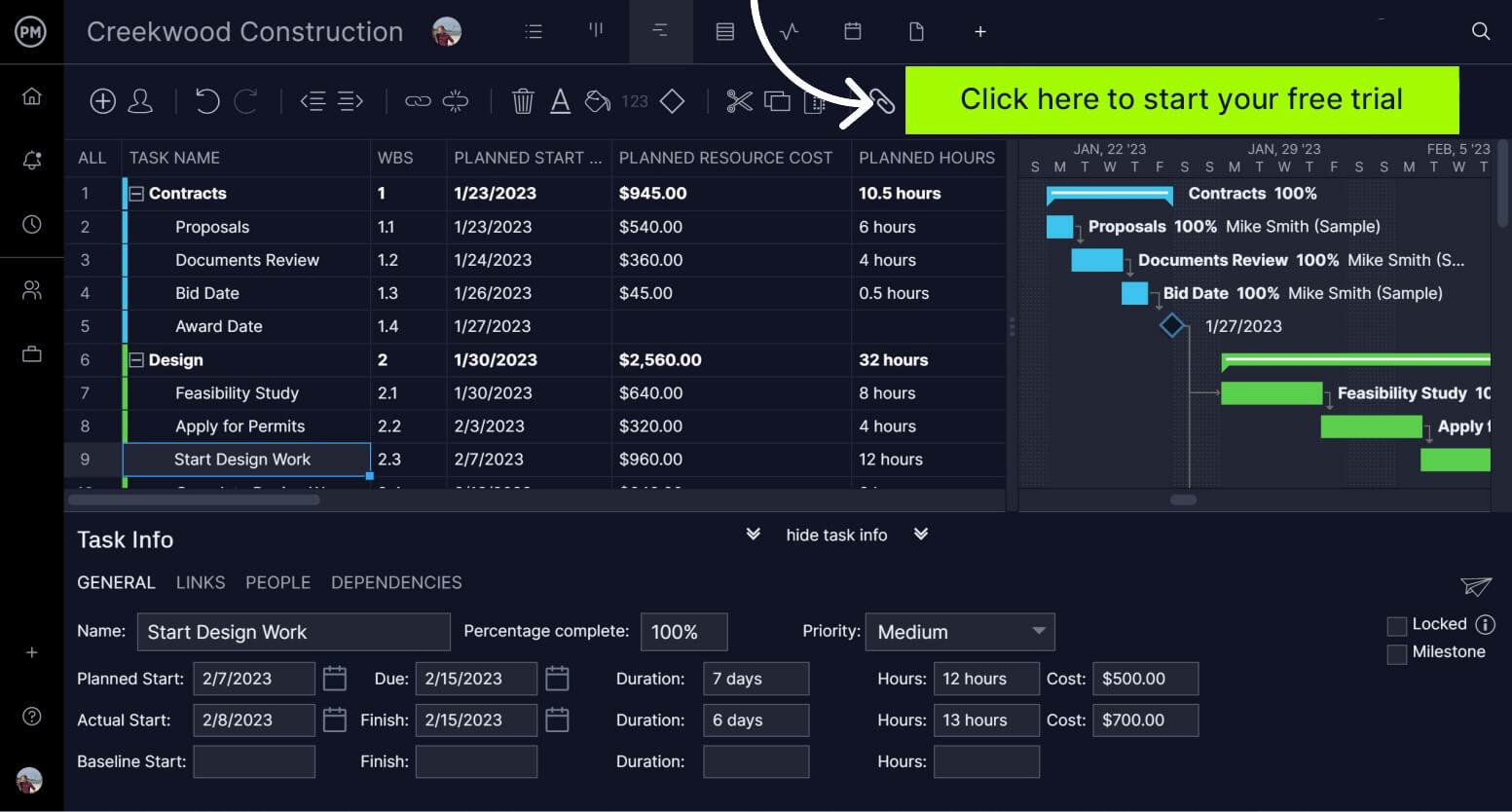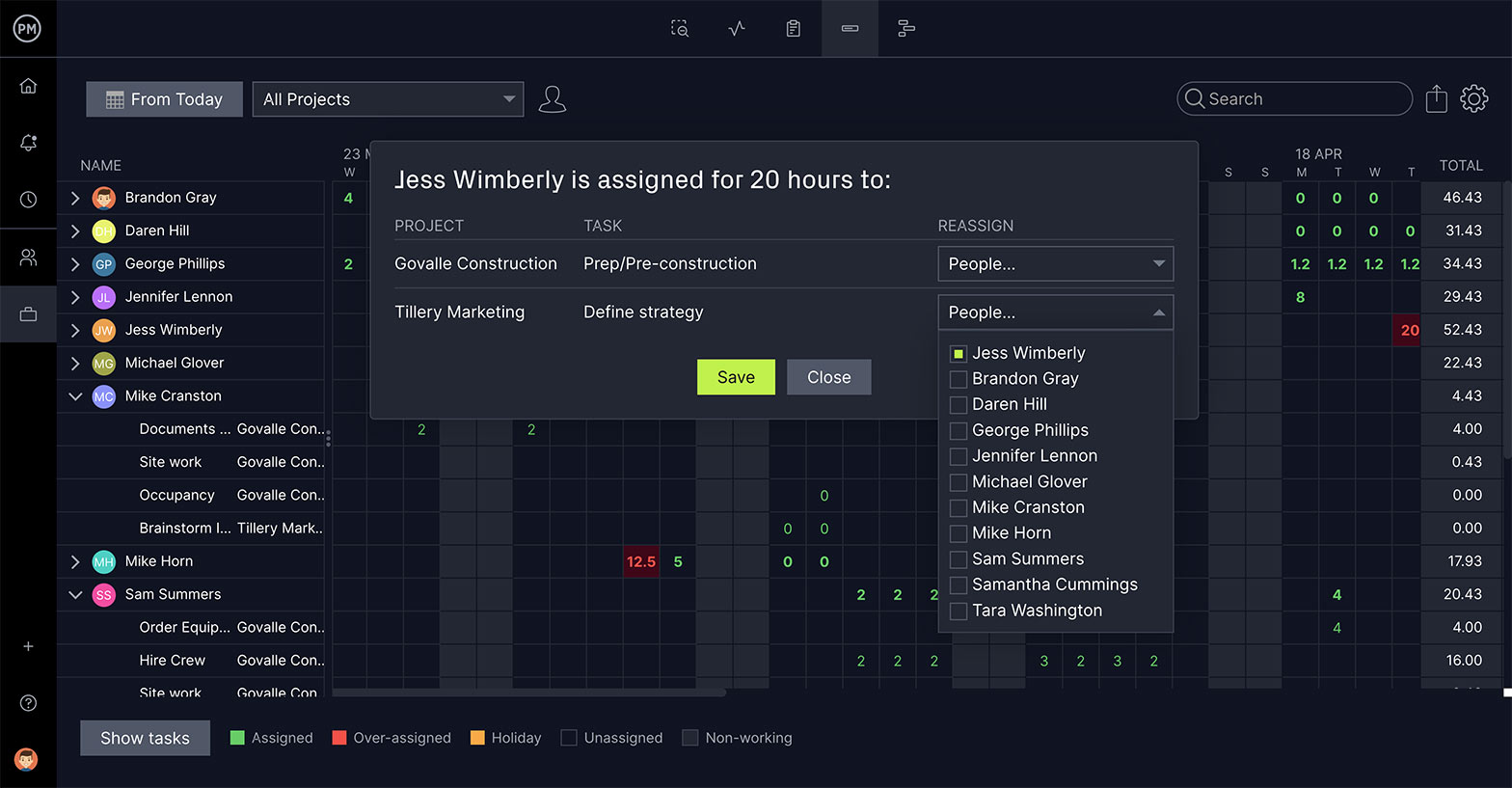Businesses aren’t projects but they share many commonalities. While businesses run projects, they also have strategies and objectives that must be met. All of these things and more make them a perfect candidate for business project management.
Let’s first explore the definition of business project management. Then, we’ll look at the role of a business project manager and the types of projects that a business will manage. Then we’ll discuss how to manage business projects (hint: it’s like project management).
What Is Business Project Management?
Business project management is the process by which internal business projects are streamlined and aligned with business strategies and objectives. These aren’t projects in the sense that they create revenue for the business. There are no clients except the business itself, which benefits from running more efficiently.
The word project, however, can mean different things depending on the industry in which the business is involved. For example, a project could be an event, the launch of a website or any endeavor that must be completed and delivered on time and within budget. Remember, a project is defined as time-bound that delivers a product or service.
While business project management differs from project management in terms of the projects it manages, the similarities are more than the differences. Therefore, business projects require the same project management tools that a construction, manufacturing or any other type of project would require.
ProjectManager is award-winning project management software that helps plan, manage and track projects in real time. Business projects, like any other type of project, require planning and scheduling to ensure they deliver on time. Using our powerful Gantt charts, business project managers can link task dependencies to avoid delays, filter for the critical path to identify essential tasks and set a baseline to track progress in real time. Get started with ProjectManager today for free.

What Is a Business Project Manager?
A business project manager is a professional who’s tasked with developing and overseeing the project team. Just as a project manager does with a project, business project managers do with business projects.
Their responsibilities are the same in that they plan, review plans, schedule tasks and monitor and control projects to ensure that they’re delivered on time without overspending. Qualifications for a business project manager depend on the industry in which they’re working. Most must have a bachelor’s degree, at least, in a related field. They should have experience, leadership skills and certifications that can help differentiate themselves.
However, some business project managers are thrown into the position without prior knowledge or experience. They’re simply told to lead this project and must get up to speed with the various methodologies and tools quickly.
Types of Business Projects
A business project manager will find themselves tasked with leading one of four types of business projects. There are strategic, operational, recurring and compliance projects. Let’s take a moment to review them.
1. Strategic Projects
A strategic project is new and tends to be innovative, such as a new product or service, though it could also be the opening of a new retail location, factory or branch office for the business. There are many examples of a strategic project, but all will be new and create a strategic advantage for the business so it can have a competitive edge. This allows the company to grow or maintain its position in the marketplace.
2. Operational Projects
An operational project is one that’s directed towards improvements. These operations are already in effect at the business, but they’re not running as efficiently as they should or there are other improvements that need to be implemented. This doesn’t have to be a major improvement, though it certainly could be, but it’ll in some way reduce costs, produce a higher quality product or some other type of operational improvement.
3. Recurring Projects
A recurring project is one that’s repeated daily, weekly, monthly, annually, etc. Even though the project is repeated, each time it’s done is time–bound and delivers on some level. Look at the technology sector to see how this plays out; they’ll deliver a product and there will inevitably be a new version delivered to the market that has new features and bug fixes. These are standalone projects, but they recur periodically throughout the life cycle of the product.
4. Compliance Projects
A compliance project, as the name suggests, is done to keep a business in compliance with an industry or government regulation or standard. These tend to be projects driven by outside forces and a business must comply to avoid fees or even shutting its operations. That doesn’t mean there’s simply one project to consider. There could be several options open to the business, any of which will result in it becoming compliant.
How to Manage Business Projects
While the projects might be different, the process is essentially the same in terms of how a business project is managed. Traditionally, a project goes through five stages in its life cycle. Those are called the project phases and they are initiation, planning, execution, monitoring and controlling and, finally, closing. Let’s take a closer look at each of these phases.
Initiation Phase
This first stage is when a project is looked at critically to determine if it’s viable and worth pursuing. Not all projects are, and if you engage in a project that’s a lost leader, you’ll sink a lot of time and money into something that won’t produce any return for the business. To find out if the project is right for the business, there are several documents that are created.
One is a business case document, which talks about the financial opportunities inherent in the project. The other is a feasibility study, which looks at the project’s goals, timeline and costs to see if it’ll make a return on its investment. One way this is done is by looking at available resources and project requirements.
Planning Phase
If the initiation phase concludes that the project is worthwhile and it’s approved by stakeholders, then the process moves into what’s called the planning phase. Now, a business project manager is charged with identifying the project requirements, creating a detailed schedule with task start and end dates, a resource management plan, a communication plan, a budget and clear project goals and deliverables.
There are techniques to help define these goals, such as using the acronym SMART, which means each goal must be specific, measurable, achievable, realistic and time-bound. Another method is CLEAR goals, which stands for collaborative, limited, emotional, appreciative and refinable. You’ll also have to define the project scope and use a work breakdown structure to determine the deliverables, which will inform what task you need to create.
Execution Phase
This phase is when you take the project plan you created and implement it. The work of completing the project starts here and the business project manager must assign and manage their project team to ensure they’re getting their work done. But more on that in a moment. Tasks are assigned and teams start completing them. Part of the success in the execution phase is fostering collaboration between team members, between the business project manager and the team and the business project manager and the project stakeholders.
Monitoring & Controlling Phase
Unlike other phases in a business project, the monitoring and controlling phase occurs at the same time as the execution phase. While the project team is executing the tasks, the business project manager is monitoring and tracking their progress and performance to ensure that they’re meeting the deadlines and quality standards set forth in the project plan. This requires setting up key performance indicators (KPIs) and critical success factors to measure the team’s progress and performance. Also, setting a baseline to capture the project plan, including the schedule and budget, allows the business project manager to compare the actual effort against the planned effort.
Closing Phase
Once the final deliverable is produced, the project isn’t officially over. There’s documentation that needs to be signed, contracts closed and the project team released from the project. However, before that happens it’s important to have a post mortem to review what worked and didn’t work in the project. This information can improve the next project.
ProjectManager Offers Business Project Management Tools
If you’re familiar with project management, then you can see that the basic working principles of business project management are the same as with project management. Both profit from the use of project management software.
ProjectManager is award-winning project management software that has task management, risk management and resource management tools to deliver your projects on time and within budget. We’ve already shown you how robust Gantt charts can plan, manage and track projects in real time, but we also have kanban boards for visual workflow, task lists to manage work and calendar views that allow stakeholders to stay updated. All project views update in real time so everyone is always working off the most current data.
Balance Resources to Keep Teams Productive
Resource management tools allow you to set the availability of your team, including PTO, vacations and global holidays for distributed teams, which makes it easier to make assignments and get everyone working. Resources can be planned at the task level on the Gantt to make sure you have what you need when you need it. To make sure they’re working at capacity but not overburdened, toggle over to the color-coded workload chart that shows the team’s task allocation. You can reallocate resources quickly from the chart to balance your team’s workload and keep them working productively without risking burnout.

Track Progress and Performance on Real-Time Dashboards
We’ve covered the planning and execution phase, and the monitoring and controlling phase requires tools like our real-time dashboard. It provides a high-level overview of the project’s progress and performance whenever you want one. The dashboard captures live data and displays it on easy-to-read graphs and charts that show metrics such as time, cost and more.
Lightweight tools require that you configure the dashboard, taking time away from managing the project. Ours is plug-and-play. We also have customizable reports that can be quickly generated to give you more details. There are status reports, portfolio reports, timesheet reports and many more. They can also be shared with stakeholders to keep them updated.

We haven’t talked much about risk management. Our risk management features let you identify risks and track issues if they show up in the project until they’re resolved. There are also recurring tasks for meetings or other tasks that need repeating daily, monthly, etc. All the tools a business project manager and their team will need are available in our software.
ProjectManager is online project management software that connects teams in the next office, in the field or anywhere they work. Share files, comment at the task level and more. Empower your teams to work collaboratively while getting transparency into their processes to clear roadblocks that could slow them down. Get started with ProjectManager today for free.


